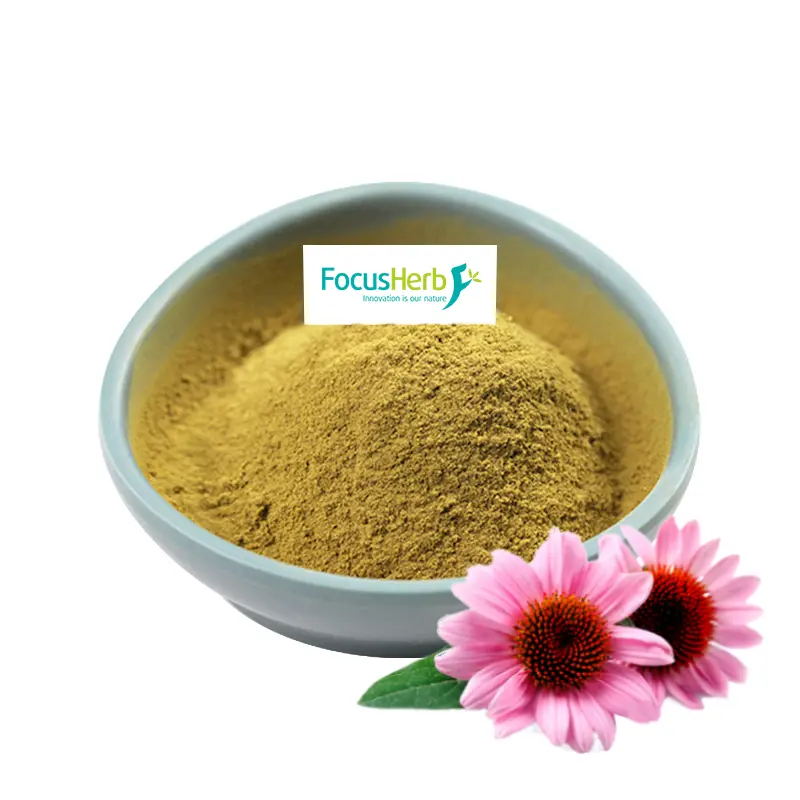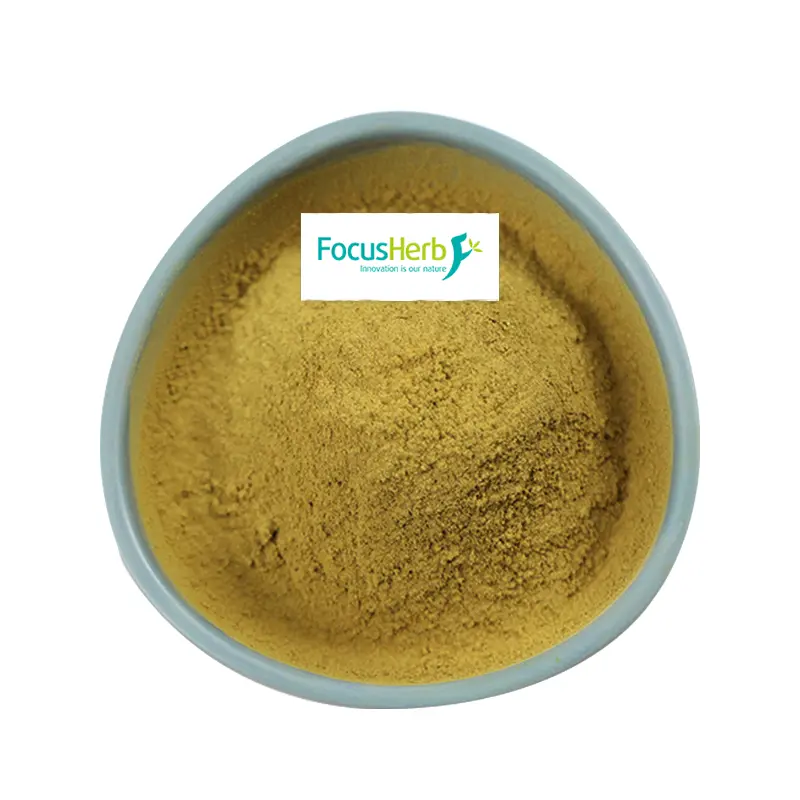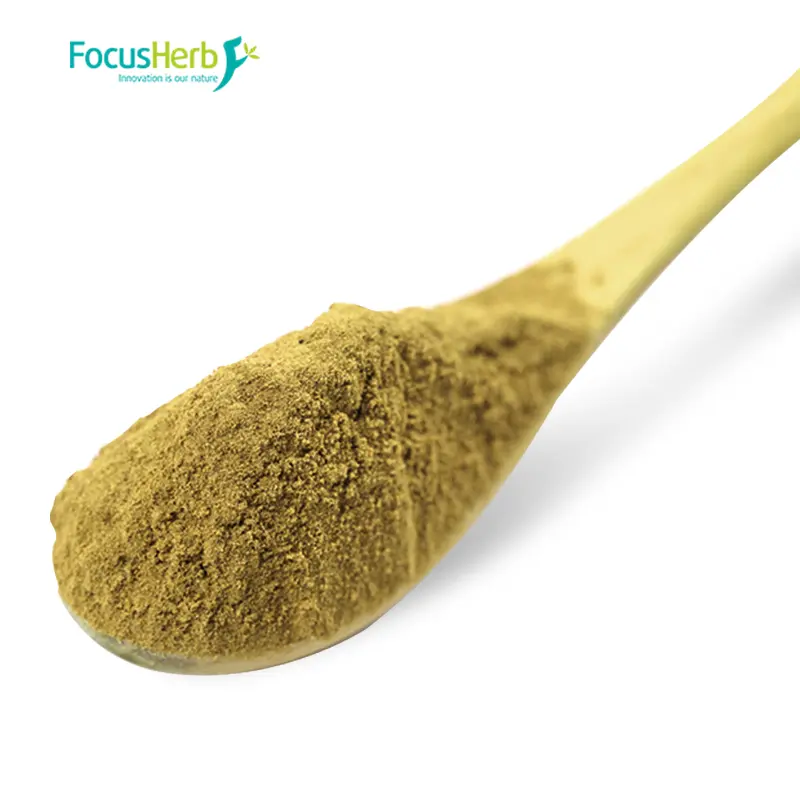Chicory Acid is a water-soluble phenolic acid compound extracted from the dried whole plants of Compositae plants such as chicory and Echinacea. It is formed by the connection of two molecules of caffeic acid and one molecule of tartaric acid through an ester bond. This unique structural combination endows Chicory Acid with many special chemical and physical properties. Please provide the text you would like translated.
The caffeic acid portion contains a catechol structure, which is a common structural unit with antioxidant activity. The hydroxyl groups in catechol can provide hydrogen atoms to combine with free radicals, thereby terminating the chain reaction of free radicals and achieving an antioxidant effect. Many compounds containing a catechol structure, such as epigallocatechin gallate (EGCG) in common tea polyphenols, have strong antioxidant capabilities, effectively eliminating excessive free radicals in the body and reducing the damage of oxidative stress to cells and tissues. Tartaric acid adds hydrophilicity and a certain degree of acidity to the molecule, which helps the stability and solubility of Chicory Acid in aqueous solutions. Please provide the text you would like translated.
Due to the presence of multiple hydrophilic groups such as hydroxyl and carboxyl groups in its molecular structure, Chicory Acid exhibits excellent water solubility and can be well dissolved in water and some polar solvents. This characteristic gives it an advantage in the absorption, transportation and metabolism processes within organisms, facilitating the exertion of its physiological activities. In some studies, the water solubility of Chicory Acid has been utilized to prepare various aqueous solution formulations for in vitro cell experiments and animal experiments to explore its mechanism of action and effects on organisms. For instance, when investigating the protective effect of Chicory Acid on cellular oxidative damage, it can be dissolved in cell culture medium for convenient uptake by cells, thereby observing its influence on the activity of antioxidant enzymes and the level of free radicals within cells. Please provide the text you would like translated.
Chicory Acid also has a certain degree of acidity, with a pKa value of approximately 1.42 ± 0.25. This acidity affects its existence form and stability in different pH environments to a certain extent, and may also participate in some chemical reactions and biological processes. In acidic environments, Chicory Acid is relatively stable, while in alkaline conditions, its structure may change, leading to a decrease in activity. When extracting and preserving Chicory Acid, the pH of the environment needs to be taken into account to ensure its activity and content. Please provide the text you would like translated.

Source and Extraction Process
Chicory Acid mainly comes from plants of the Asteraceae family, among which chicory and Echinacea purpurea are the most common raw materials. Chicory, a plant that is both medicinal and edible, is widely distributed globally, has strong adaptability, and is easy to cultivate. Its above-ground parts are often discarded in agricultural production but are rich in Chicory Acid, making chicory a highly potential raw material for extracting Chicory Acid. This not only effectively utilizes resources but also reduces production costs. Echinacea purpurea is also rich in Chicory Acid, especially in its flowers and roots, with considerable content. Please provide the text you would like translated.
The traditional extraction process of Chicory Acid mainly adopts the hot reflux extraction method. This method involves heating the medium to change the intermolecular interactions through temperature variations, thereby achieving the separation of components. In practical operation, the raw materials of chicory or Echinacea are crushed and then mixed with an appropriate amount of solvent (such as water or ethanol), followed by extraction under heating reflux conditions. However, this method has many drawbacks. On the one hand, the extraction rate is relatively low, failing to fully obtain the Chicory Acid from the raw materials, which leads to a waste of resources. On the other hand, the extraction process requires a high temperature, and Chicory Acid is sensitive to heat. High temperatures can easily cause structural damage to it, resulting in the loss of active components and affecting the quality and efficacy of the product. In the research on the extraction of Chicory Acid from Echinacea, it was found that the content of Chicory Acid obtained by the hot reflux extraction method was relatively low, and after high-temperature treatment, some Chicory Acid decomposed, with its antioxidant and other biological activities significantly reduced. Please provide the text you would like translated.
With the continuous advancement of technology, new extraction techniques have gradually been applied to the extraction process of Chicory Acid, providing new ways to improve extraction efficiency and product quality. Supercritical CO₂ fluid extraction technology is one of them. This technology utilizes CO₂ in a supercritical state to extract at a relatively low temperature (35 – 40℃) and under the cover of CO₂ gas. In the supercritical state, CO₂ has the diffusivity of a gas and the solubility of a liquid, enabling it to rapidly penetrate into the interior of plant cells and dissolve Chicory Acid within. Compared with traditional methods, supercritical CO₂ fluid extraction technology has many advantages. It can extract at a lower temperature, avoiding the damage to Chicory Acid caused by high temperatures and preserving its active components to the greatest extent. This technology has a high extraction efficiency, allowing for a more thorough separation of Chicory Acid from raw materials, thereby increasing the purity and yield of the product. Relevant studies have shown that the dry extract yield of Chicory Acid extracted by supercritical CO₂ fluid extraction technology is significantly higher than that of traditional processes, and the Chicory Acid content is higher and the quality is more stable. However, this technology also has some limitations, such as high equipment costs, requiring specialized high-pressure equipment and complex operation procedures, which to some extent restricts its large-scale industrial application. Please provide the text you would like translated.
Ultrasonic-assisted extraction technology is also a novel extraction method. It utilizes the cavitation effect, mechanical vibration and thermal effect of ultrasonic waves to enhance the mass transfer process and accelerate the release of Chicory Acid from plant cells into the solvent. Under the action of ultrasonic waves, solvent molecules can penetrate into the plant tissue more rapidly and come into full contact with Chicory Acid, thereby improving the extraction efficiency. Meanwhile, ultrasonic waves can also break down the plant cell walls, making it easier for Chicory Acid inside the cells to dissolve. Some studies have adopted the ultrasonic-assisted extraction method to extract Chicory Acid from chicory. By optimizing parameters such as ultrasonic power, extraction time and solvent concentration, the extraction rate of Chicory Acid was significantly increased and the extraction time was shortened. Compared with the traditional hot reflux extraction method, the ultrasonic-assisted extraction method has the advantages of short extraction time, low energy consumption and high extraction rate, and shows a promising application prospect in the extraction of Chicory Acid. Please provide the text you would like translated.
Microwave-assisted extraction technology has also been applied in the extraction of Chicory Acid. Microwaves can cause rapid vibration of polar molecules such as water molecules within plant cells, generating internal heat and causing cell rupture, thereby releasing Chicory Acid. By taking advantage of the rapid heating characteristic of microwaves, the required extraction temperature can be reached in a relatively short time, improving the extraction efficiency. German researchers have utilized microwave-assisted extraction technology to achieve efficient extraction of Chicory Acid while reducing the amount of solvent used. By precisely controlling factors such as microwave power, time, and the type and amount of solvent, the extraction process can be optimized to obtain Chicory Acid with high purity and yield. Microwave-assisted extraction technology features uniform heating, high speed, and good selectivity, providing an efficient and energy-saving method for the extraction of Chicory Acid.
Extensive Biological Activities and Applications
(I) Medical Field
Chicory Acid has demonstrated extensive and remarkable biological activities in the medical field, providing new ideas and hope for the treatment and prevention of many diseases. Its significant anti-inflammatory effects have been confirmed in multiple studies, effectively inhibiting the release of inflammation-related cytokines such as tumor necrosis factor-α (TNF-α) and interleukin-6 (IL-6). These cytokines play a crucial role in the inflammatory response, and their overexpression can trigger a series of inflammatory diseases, such as arthritis and enteritis. By suppressing the production of these cytokines, Chicory Acid reduces the inflammatory response, alleviates pain and swelling, and brings good news to patients with inflammatory diseases. In animal models of arthritis, after treatment with Chicory Acid, the degree of joint swelling in the animals was significantly reduced, the infiltration of inflammatory cells decreased, and joint function improved. Please provide the text you would like translated.
Chicory Acid also has the function of enhancing the immune system, capable of regulating the balance of the immune system and improving the body’s resistance. It can promote the proliferation and activity of immune cells, such as T lymphocytes, B lymphocytes, and macrophages. These immune cells are important components of the human immune system, and their normal functions are crucial for resisting pathogen invasion and maintaining good health. By enhancing the functions of immune cells, Chicory Acid enables the body to better cope with the challenges of various diseases. Studies have found that Chicory Acid can enhance the phagocytic ability of macrophages and their clearance of pathogens; it can also promote the activation and proliferation of T lymphocytes, enhancing cellular immune responses. In some animal models with weakened immune function, after supplementing with Chicory Acid, the immune function of the animals was significantly improved, and their resistance to pathogens was enhanced. Please provide the text you would like translated.
Inducing apoptosis is also one of the important biological activities of Chicory Acid. Apoptosis is a programmed cell death process that is crucial for maintaining intracellular homeostasis and normal tissue development. In certain disease states, such as cancer, the apoptosis mechanism is disrupted, leading to abnormal proliferation of cancer cells. Chicory Acid can induce apoptosis in cancer cells by regulating apoptosis-related signaling pathways. It can activate caspase family proteases, which are key executors of apoptosis and can cleave various intracellular substrates, leading to the occurrence of apoptosis. Chicory Acid can also regulate the expression of Bcl-2 family proteins, which include pro-apoptotic and anti-apoptotic proteins. The balance between these proteins determines the life and death of cells. Chicory Acid induces apoptosis in cancer cells by up-regulating the expression of pro-apoptotic proteins and down-regulating the expression of anti-apoptotic proteins, disrupting the apoptotic balance within cancer cells. In various cancer cell lines, such as breast cancer cells and lung cancer cells, Chicory Acid has shown significant effects in inducing apoptosis. Please provide the text you would like translated.
Chicory Acid also has the effect of inhibiting HIV-1 and HIV-1 integrase, which provides a potential drug target for the treatment of AIDS. HIV-1 integrase is a key enzyme in the replication process of the HIV virus. It can integrate the viral DNA into the host cell’s genome, thereby achieving viral replication and transmission. Chicory Acid inhibits the replication of the HIV virus by blocking the integration process of viral DNA through the inhibition of the activity of HIV-1 integrase. Studies have shown that Chicory Acid has a high affinity for HIV-1 integrase and can specifically bind to the enzyme’s active site, thereby inhibiting its activity. In vitro experiments have shown that Chicory Acid can effectively inhibit the infection and replication of the HIV virus and reduce the viral load. Although the application of Chicory Acid in the treatment of AIDS is still in the research stage at present, it provides a new direction for the development of new anti-AIDS drugs. Please provide the text you would like translated.
In recent years, remarkable achievements have been made in the research on Chicory Acid in the treatment of respiratory tract infections, acute kidney injury, ototoxic hearing loss and other diseases. Professor Li Feng’s team from Shandong University of Traditional Chinese Medicine screened and discovered the active component Chicory Acid from Echinacea purpurea with anti-respiratory syncytial virus (RSV) activity, and developed it into a convenient and practical aerosol. RSV is one of the main pathogens causing respiratory tract infections in infants and young children, and there is currently a lack of effective therapeutic drugs in clinical practice. The Chicory Acid aerosol can directly act on the respiratory tract, has strong targeting, and shows significant therapeutic effects. Through a series of experimental studies, including cell experiments, animal experiments and preliminary clinical trials, it has been confirmed that the Chicory Acid aerosol has a good therapeutic effect on RSV infection, can reduce respiratory tract inflammation, and relieve symptoms such as cough and wheezing. Please provide the text you would like translated.
In studies on acute kidney injury induced by sepsis, Chicory Acid has also demonstrated protective effects. Sepsis is a severe systemic infectious disease that often leads to acute kidney injury, posing a serious threat to patients’ lives and health. Research has found that Chicory Acid can alleviate renal inflammatory responses, reduce tubular injury and improve renal dysfunction by inhibiting M1 macrophage polarization and promoting the phenotypic transformation of M2 macrophages. In experiments, a mouse model of acute kidney injury due to sepsis was established by intraperitoneal injection of lipopolysaccharide (LPS). After treatment with Chicory Acid, the levels of inflammatory factors in the kidneys of mice were significantly reduced, tubular injury was alleviated, and renal function was significantly improved. Please provide the text you would like translated.
Chicory Acid has also made significant discoveries in protecting hair cells from damage caused by ototoxic drugs. Ototoxic drugs such as aminoglycoside antibiotics often lead to irreversible damage to hair cells, thereby causing ototoxic hearing loss. Research using a transgenic zebrafish model has found that Chicory Acid can exert antioxidant and anti-inflammatory properties by scavenging free radicals, reducing neomycin-induced hair cell death. In the experiment, pretreatment of transgenic zebrafish with 5 μmol/L Chicory Acid for 2 hours significantly inhibited neomycin-induced hair cell death, reduced apoptotic signals, restored the function of the mechanical transduction apparatus, and effectively rescued the motor dysfunction caused by neomycin exposure. Please provide the text you would like translated.
(2) Food Industry
In the food industry, Chicory Acid has emerged as a highly valuable natural preservative due to its excellent antioxidant properties. As consumers’ concerns about food safety and health continue to rise, natural preservatives are gradually replacing synthetic chemical preservatives and have become a research hotspot in the food industry. The antioxidant effect of Chicory Acid can effectively inhibit lipid oxidation, protein denaturation, and the growth and reproduction of microorganisms in food, thereby extending the shelf life of food. In oil-based foods, lipids are prone to oxidation under the influence of factors such as oxygen, light, and temperature, generating peroxides and free radicals, which leads to rancidity and unpleasant odors and tastes. Chicory Acid can provide hydrogen atoms to combine with free radicals, terminating the chain reaction of free radicals and thus inhibiting lipid oxidation. Studies have shown that when Chicory Acid is added to soybean oil, it can significantly reduce the peroxide value and acid value of soybean oil, extending its shelf life. Please provide the text you would like translated.
Chicory Acid can also add certain health benefits to food, meeting consumers’ demands for healthy food. In the development of functional foods, the application of Chicory Acid is becoming increasingly widespread. A number of functional beverages, health foods and other products rich in Chicory Acid have been launched one after another. These products not only have unique flavors but also provide consumers with multiple health benefits such as antioxidation, anti-inflammation and immune regulation. For instance, some brands have launched functional beverages containing Chicory Acid, with chicory extract as the main ingredient and a moderate amount of fruit juice and other nutrients added. They have a refreshing taste and are deeply loved by consumers. The Chicory Acid in these beverages can help consumers eliminate free radicals in the body, reduce oxidative stress and enhance immunity. Please provide the text you would like translated.
(3) Cosmetics Field
The antioxidant and moisturizing properties of Chicory Acid have made it shine in the cosmetics field, becoming an excellent natural additive. In skin care products, Chicory Acid can effectively protect skin cells from damage caused by external environments such as ultraviolet rays and pollution. Ultraviolet rays are one of the main factors leading to skin aging; they can trigger skin cells to produce a large number of free radicals, which attack components such as collagen and elastic fibers in the skin, causing problems like skin laxity, increased wrinkles, and the formation of pigmentation spots. The antioxidant effect of Chicory Acid can eliminate free radicals induced by ultraviolet rays, reducing damage to skin cells and thereby delaying skin aging. Some anti-wrinkle creams contain Chicory Acid. Clinical experiments have verified that after using creams containing Chicory Acid for a period of time, the depth and number of wrinkles on the skin are significantly reduced, and skin elasticity is improved. Please provide the text you would like translated.
The moisturizing properties of Chicory Acid also add to its appeal in cosmetics. Maintaining skin moisture is a crucial factor for keeping the skin healthy and beautiful. Dry skin is prone to problems such as roughness, flaking, and itching. The multiple hydroxyl and carboxyl groups in the Chicory Acid molecule, which are hydrophilic, can form hydrogen bonds with water molecules, thereby absorbing and retaining moisture and increasing the skin’s water content. Adding Chicory Acid to moisturizing lotions enables the lotion to better penetrate the deep layers of the skin, providing long-lasting moisturizing effects. After consumers use moisturizing lotions containing Chicory Acid, the moisture content of their skin significantly increases, and the feeling of dryness is noticeably reduced. Please provide the text you would like translated.
In whitening products, Chicory Acid can also play a certain role. The color of the skin is mainly determined by the content and distribution of melanin, which is a pigment produced by melanocytes. Factors such as ultraviolet rays, endocrine disorders, and inflammation can stimulate melanocytes to produce more melanin, causing the skin to darken. Chicory Acid can reduce the synthesis of melanin by inhibiting the activity of tyrosinase. Tyrosinase is a key enzyme in the melanin synthesis process, which can catalyze the conversion of tyrosine to dopaquinone and then synthesize melanin. Chicory Acid can bind to tyrosinase and inhibit its activity, thereby reducing the production of melanin. Some whitening essence liquids contain Chicory Acid. After consumer trials, it was found that after using it for a period of time, the skin’s pigmentation spots were significantly lightened, and the skin tone became more even and fair.
Research Status and Challenges
In recent years, significant progress has been made in the study of Chicory Acid, demonstrating its great potential in multiple fields. In terms of the analysis of the biosynthetic pathway, researchers have achieved important breakthroughs. In 2021, the research team led by Professor Yang Zhang from the College of Life Sciences at Sichuan University published a research paper in Nature Communications, successfully and completely elucidating the biosynthetic pathway of Chicory Acid, the main active component in Echinacea purpurea. The study found that the biosynthesis of Chicory Acid involves two major families of acyltransferases in plants, BAHD and SCPL. In the cytoplasm, two BAHD family members, EpHTT and EpHQT, respectively catalyze the reactions of caffeoyl-CoA with tartaric acid and quinic acid to generate caffeoyltartaric acid and chlorogenic acid. These two products then enter the vacuole and are catalyzed by the SCPL family member EpCAS to produce Chicory Acid and quinic acid. This discovery not only expands the understanding of the SCPL family of acyltransferases but also confirms that this pathway is unique to Echinacea purpurea, suggesting that the biosynthetic pathway of Chicory Acid may have undergone convergent evolution in different species. Please provide the text you would like translated.
The application of new extraction technologies in the extraction of Chicory Acid has also achieved positive results. Techniques such as ultrasonic-assisted extraction, microwave-assisted extraction, and supercritical CO₂ fluid extraction have gradually been applied in the extraction process of Chicory Acid. These technologies utilize different physical principles, such as the cavitation effect of ultrasonic waves, the rapid heating characteristics of microwaves, and the special solubility of supercritical fluids, to enhance the extraction efficiency and purity of Chicory Acid. American scholars have adopted the ultrasonic-assisted extraction method, significantly reducing the extraction time and increasing the extraction rate of Chicory Acid. German researchers have utilized microwave-assisted extraction technology, achieving efficient extraction of Chicory Acid while reducing the amount of solvent used. Domestic studies have also employed the ultrasonic-assisted enzymatic hydrolysis method, combining the efficient catalytic effect of enzymes and the enhanced mass transfer effect of ultrasonic waves, further increasing the extraction rate of Chicory Acid. Please provide the text you would like translated.
Although certain achievements have been made in the research of Chicory Acid, it still faces many challenges at present. In terms of extraction technology, although the existing techniques have improved the extraction rate and purity of Chicory Acid to a certain extent, there are still problems such as high extraction cost, complex process, and certain environmental impact. Although supercritical CO₂ fluid extraction technology has the advantages of high extraction efficiency, high product purity, and no pollution, its equipment cost is high, and it requires specialized high-pressure equipment and complex operation procedures, which to some extent limits its large-scale industrial application. Some new extraction technologies still need to further optimize process parameters to improve their stability and repeatability. Please provide the text you would like translated.
Chicory Acid also faces some issues in pharmacological research. Although it exhibits various biological activities, the window between its pharmacological concentration and toxic concentration is narrow, with a safety factor of less than 3. When developing drugs based on Chicory Acid, it is necessary to precisely control its dosage to ensure therapeutic effects while avoiding toxic reactions. Currently, further in-depth research is needed on the metabolic process and mechanism of action of Chicory Acid in the human body, which is of great significance for its clinical application. Please provide the text you would like translated.
The quality evaluation standards for Chicory Acid products also need to be unified. The fingerprint chromatogram standards established by different research institutions vary, and there is a lack of unified norms and standards, which brings certain difficulties to the quality evaluation and standardization of chicory extracts. Currently, the fingerprint chromatograms mainly focus on the overall characterization of chemical components, but there is less research on the interrelationships among the components and their association with biological activities. Establishing a unified and scientific quality evaluation standard is crucial for ensuring the stability and consistency of Chicory Acid product quality and promoting the healthy development of the Chicory Acid-related industry.
Looking ahead
Chicory Acid shows broad application prospects in multiple fields. In the area of new drug development, with the in-depth study of the pharmacological mechanism of Chicory Acid, it is expected that more effective drugs for major diseases such as inflammatory diseases, cancer, and AIDS will be developed. Especially in the current context of the global increasing demand for natural medicines, Chicory Acid, as a natural compound with multiple biological activities, has great potential in new drug development. For inflammatory bowel disease, the current treatment drugs have many side effects, while the anti-inflammatory and immune-regulating functions of Chicory Acid make it possible to become a new type of drug for treating inflammatory bowel disease. In the future, further research can be conducted on the metabolic process and action targets of Chicory Acid in the body, optimize the drug dosage form and administration method, and improve the efficacy and safety of the drug. Please provide the text you would like translated.
In the field of functional product development, Chicory Acid will also play a significant role. With the increasing health awareness of people, the demand for functional foods and cosmetics is growing. The antioxidant, anti-inflammatory and moisturizing properties of Chicory Acid make it an ideal raw material for the development of functional foods and cosmetics. In terms of functional foods, beverages, snacks, health supplements and other products rich in Chicory Acid can be developed to meet consumers’ demands for health and nutrition. For example, the development of sports drinks containing Chicory Acid can not only replenish water and electrolytes but also help athletes relieve fatigue and enhance immunity. In the cosmetics industry, high-end skin care products, makeup and other products with Chicory Acid can be further developed to meet consumers’ demands for natural and efficient skin care and beauty. For instance, Chicory Acid face cream with antioxidant and whitening effects can be developed to help consumers improve dull skin and reduce the formation of pigmentation. Please provide the text you would like translated.
In-depth research on the biological activities and mechanisms of action of Chicory Acid, as well as continuous innovation in extraction and application technologies, is the key to unlocking its potential value. In the future, it is necessary to strengthen interdisciplinary cooperation, integrating knowledge and technologies from multiple disciplines such as pharmacy, biology, chemistry, and materials science to jointly promote the research and application of Chicory Acid. Strengthening quality control and standardization of Chicory Acid products, establishing unified quality evaluation standards and detection methods, is essential to ensure the quality and safety of the products. Only in this way can the advantages of Chicory Acid be fully exploited, and the healthy and sustainable development of related industries be promoted. Please provide the text you would like translated.






















